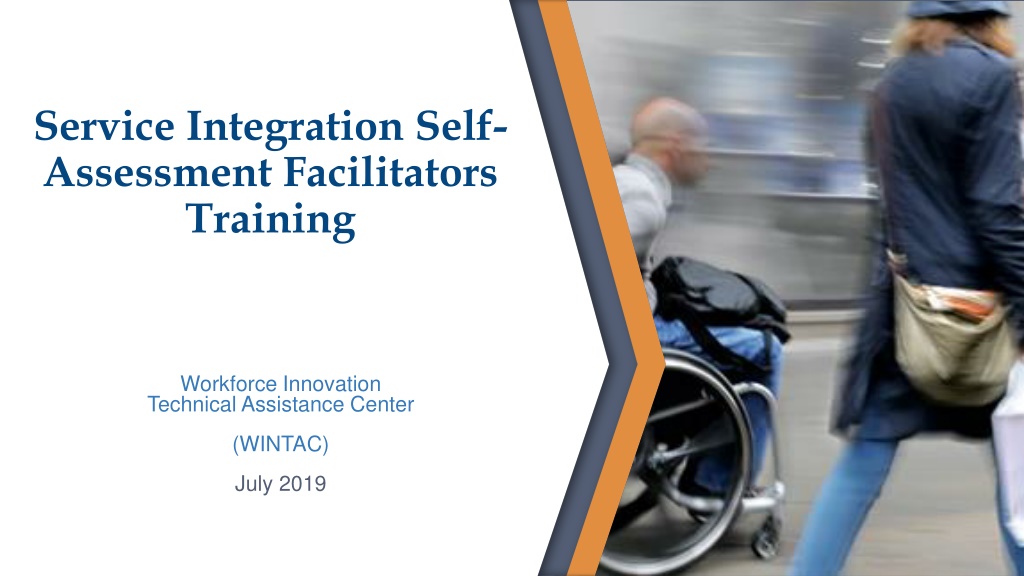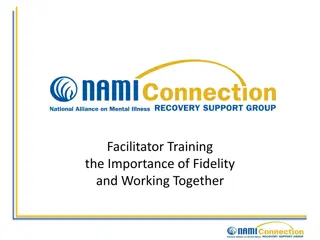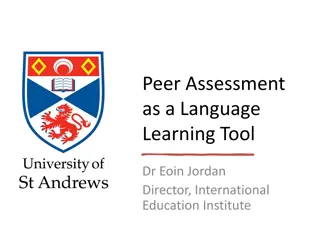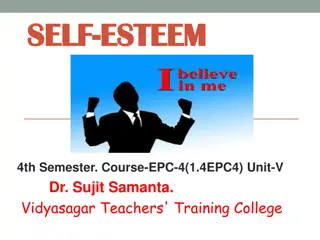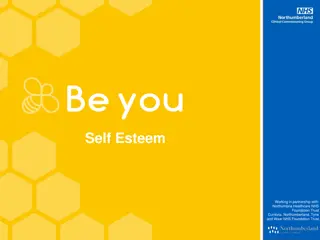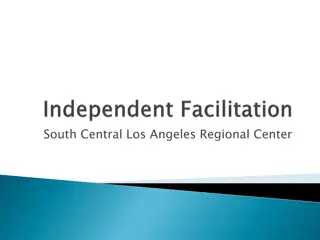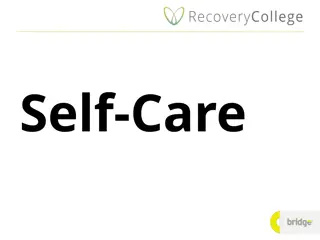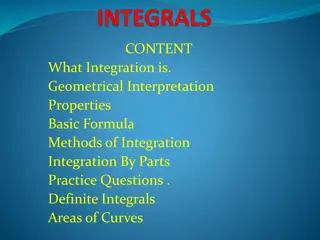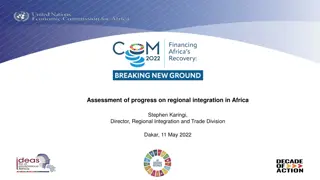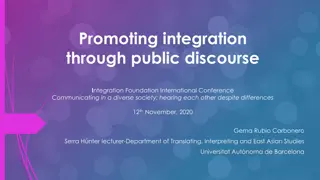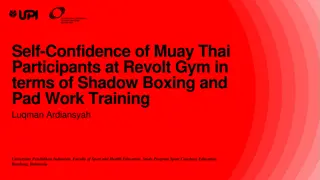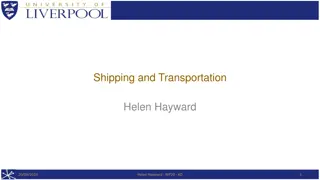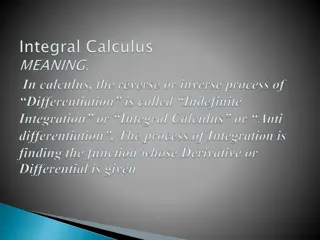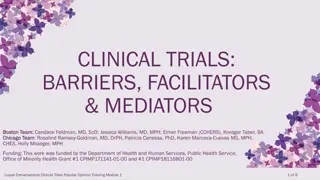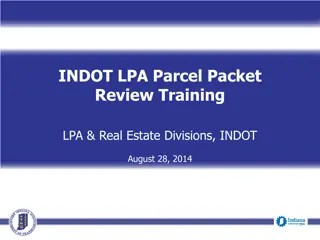Service Integration Self-Assessment Facilitators Training WINTAC
Explore the training program for Service Integration Self-Assessment Facilitators conducted by the Workforce Innovation Technical Assistance Center (WINTAC) in July 2019. Discover learning objectives, meeting agenda, facilitator preparation, and insights into service integration practices. Engage with experts and peers to enhance your skills in assessing and prioritizing service integration goals.
Download Presentation

Please find below an Image/Link to download the presentation.
The content on the website is provided AS IS for your information and personal use only. It may not be sold, licensed, or shared on other websites without obtaining consent from the author. Download presentation by click this link. If you encounter any issues during the download, it is possible that the publisher has removed the file from their server.
E N D
Presentation Transcript
Service Integration Self- Assessment Facilitators Training Workforce Innovation Technical Assistance Center (WINTAC) July 2019
Presenters Lou Adams Training and TA Manager, WINTAC ladams@ndi-inc.org Doug Keast Project Director, WINTAC dkeast@ndi-inc.org 2
Learning Objectives 1. Participants will learn how their role fits into the broader efforts of the Illinois Workforce Innovation Board, the WIOA core and required partners, and other related efforts to improve the integration of services. 2. Participants will become familiar with the state service integration goals and the steps needed to achieve those goals 3. Participants will understand the intent, logic, and steps associated with the self-assessment and prioritization, action planning processes. 4. WINTAC staff will provide sufficient information, materials, modeling, consultation and techniques for the participants to successfully facilitate the self-assessment and prioritization, action planning. 5. Participants will learn how other LWIA teams are addressing the service integration goals and deepen their understanding of different approaches, priorities, and actions. 6. Participant will learn specific techniques to handle group dynamics such as resistance, silence, domination by group members, cynics, bystanders, and lack of consensus. 3
Meeting Agenda Introductions WIOA Vision: State, Regional and/or Local Objectives Integration Continuum and State Goal Examples Integration Continuum Assessment (Small Groups) Priority Areas Discussion (Small Groups) Each group identifies 2-3 areas they would like to work on locally this year. Each group identifies priority area activities for the coming year. Priority Areas Report Out (Large Group) Share their priority areas and proposed activities. Consider regional goals. Implementation Considerations (Small Groups) Consider issues around capacity to accomplish your activities. Identify areas where you will need assistance, and consider who might provide it. Debrief and Next Steps 4
Facilitator Preparation Planning with Leadership Expertise of Partners as a mindset Establish the planning team Preparatory Planning sending out information in advance Work through basic logistics Time Location Room set up 5
What is Service Integration? Service integration involves: A combination of strategies to align and simplify access to client services and supports with the goal of providing the best experience possible. Implementation of a distinctive mix of partner agencies, strategies and processes based on the resources available, the needs of the clients served and WIOA requirements. The introduction of innovative practices into Core Programs service systems which have a positive impact on: Service delivery policies and procedures Management information systems Performance management systems o o o 6
Benefits of Integrated Service Delivery Economize scarce resources Enhance job seeker, claimant, customer outcomes Provide effective services to employers Boost data availability Improve performance accountability 7
The Concept of Continuum Not every system or process can change at the same time. Core partners will be at different stages of the continuum at different times. It is important to recognize the stages of the interaction between the core partners so you can determine where you are at present, and develop plans to move to the next stage. Some plan elements will be easier to implement than others. Core partners may not be able to move at the same pace. 8
Self-Assessment How does self-assessment help us? Provides an environmental scan Identifies which partnerships might be strategically strengthened Meets agency operational objectives Meets customer objectives Establishes a basis for evaluating agency progress 9
Are We Collaborating? Levels of Collaboration Created by WINTAC based on Stages of Integration; Burt and Spellman 2007 10
Isolation Each agency and program has its own separate career service options. Agencies and programs do not regularly inform partners of those services. Each separate agency and program promotes services separately to community. 11
Communication Core agencies talk to each other, but they have no planned or required contact. Contact is intermittent. Some information is shared, but no formal information or data sharing plan exists. 12
Coordination Core partners work together at all levels (from management to direct service) to align services, but there is no formal structure to their interaction. It is done on a case-by-case basis. 13
Collaboration Core agencies agree to work together for mutual benefit. The relationship is based on consistent communication and coordination. Partners agree they can best achieve goals by working together and using the strengths and expertise of each partner to accomplish common goals. 14
Integration Core agencies agree to work together to achieve common goals and create an organizational structure to share information, data and resources to accomplish mutually agreed upon outcomes as an integrated system. 15
Continuum Definitions Characteristics and Resource Sharing Isolation Communication Coordinating Collaborating Integration Exchanging information for mutual benefit, without altering activities Exchanging information for mutual benefit, and altering activities to achieve a common purpose oftentimes on a case by case basis Moderatetime commitments, moderate levels of trust, and no necessity to share turf; making access to services or resources more user-friendly is the primary focus No or minimal mutual sharing of resources perhaps on a case-by-case basis Exchanging information for mutual benefit, and altering activities and sharing resources to achieve a common purpose Exchanging information for mutual benefit, and altering activities, sharing resources, and enhancing the capacity of the system to achieve a common purpose Extensive time commitments, very high levels of trust and extensive areas of common turf; enhancing each other s capacity to achieve a common purpose is the primary focus Definition No exchange of information No time commitments no trust, turf or information issues Minimal time commitments, limited levels of trust, and no necessity to share turf; information exchange is the primary focus Substantial time commitments, high levels of trust, and significant access to each other s turf; sharing of resources to achieve a common purpose is the primary focus Characteristics No mutual sharing of resources necessary. Moderate to extensive mutual sharing of resources of risks, resources and responsibilities. Extensive sharing of resources, and full sharing of resources, risks and responsibilities. No sharing of resources Resources 16
Integration Continuum Self-Assessment This self-assessment looks at your level of connectivity to other American Job Center (AJC) One-Stop Partners. There is no right or wrong level except Isolation, the desire is to do what best serves your customers and the customers of the American Job Center system. The intent is to provide a dashboard of those Partners with whom you are connected as well as your current level of connectivity. It can be done every year to track levels of partnerships with various AJC Partners. 17
Group Assessment and Planning Process Assess the current level of engagement and connectivity between core, required and other American Job Center (AJC) partners on specific offerings and activities; Join with staff and partners in discussions regarding the outcome of the assessment results; Identify any local considerations and possible opportunities to strengthen or develop improved partnerships; Assist teams with short- and long-term planning and establishment of ongoing evaluation for informing, shaping and measuring efforts, outcomes; and Evaluate progress and provide a renewed focus. 18
Customer Centered Design ISOLATION COMMUNICATIONCOORDINATIONCOLLABORATIONINTEGRATION Function and Goal Customer input drives service design for job seekers, employers and system customers Each agency promotes services separately to community. Partner agencies do not use customer input to design and integrate services. Partner agencies share information about service design related to customer input with each other. Mechanisms that collect customer input concerning service design have been developed. Regular meetings, including discussion at Local Workforce Innovation Board (LWIB) meetings, are held to analyze and discuss both job seeker and business customer input. Partners meet regularly and plan service design together. Partner agencies still approach service design separately, but share information with each other to meet customer needs. Teams representing all partner programs, the one-stop operator, and the LWIB regularly use customer feedback to design, implement and improve all aspects of service delivery. 19
Staff Goal 1 - Competencies Function and Goal Staff Goal 1: Job competencies and expectations (as defined in the Self- Assessment Guide) are communicated to one-stop staff COMMUNICATION COORDINATION COLLABORATION INTEGRATION ISOLATION Staff and leadership are not trained on core job competencies, organizational values, and performance expectations related to their role in service integration. Staff and leadership are rarely trained on core job competencies, organizational values, and performance expectations related to their role in service integration. Staff and leadership are sometimes trained on core job competencies, organizational values, and performance expectations related to their role in service integration. Staff and leadership are usually trained on core job competencies, organizational values, and performance expectations related to their role in service integration. A process in place to ensure staff and leadership are regularly trained on core job competencies, organizational values, and performance expectations related to their role in service integration. 20
Staff Goal 3 - Communication FUNCTION AND GOAL Communi- cation is consistent, comprehen sive, and timely ISOLATION COMMUNICATION COORDINATION COLLABORATION INTEGRATION All staff are not informed of changes, updates, trends in service design, program policies, and services to customers. All staff are rarely informed of changes, updates, trends in service design, program policies, and services to customers. All staff are sometimes informed of changes, updates, trends in service design, program policies, and services to customers. All staff are usually informed of and trained on changes, updates, trends in service design, program policies, and services to customers. A process is in place to ensure all staff are regularly informed of changes, updates, trends in service design, program policies, and services to customers. 22
Staff Goal 3 - Communication FUNCTION AND GOAL Staff Goal 3 - Communication ISOLATION COMMUNICATION COORDINATION COLLABORATION INTEGRATION Regular meetings are not held with on-site staff. Communication vehicles, such as newsletters and meeting minutes, are not utilized to provide important information to one-stop staff (whether on- site or off-site). Regular meetings are rarely held with on-site staff. Communication vehicles, such as newsletters and meeting minutes, are rarely utilized to provide important information to one-stop staff (whether on-site or off- site). Regular meetings are sometimes held with on-site staff. Other communication vehicles, such as newsletters and meeting minutes, are used to provide important information to one- stop staff who may be off-site or unable to attend staff meetings. Regular meetings are usually held with on- site staff. Other communication vehicles, such as newsletters and meeting minutes, are used to provide important information to one-stop staff who may be off-site or unable to attend staff meetings. Regular meetings are held with on- site staff. Other communication vehicles, such as newsletters and meeting minutes, are used to provide important information to one-stop staff who may be off-site or unable to attend staff meetings. 23
Staff Goal 4 Team Members are Valued and Respected FUNCTION AND GOAL Staff Goal 4: ISOLATION COMMUNICATION COORDINATION COLLABORATION INTEGRATION Staff do not communicate suggestions and concerns to management on such issues as customer flow, customer services, and related issues for continuous improvement purposes. A process is not in place, but on-site staff are able to share suggestions and concerns to management on such issues as customer flow, customer services, and related issues for continuous improvement purposes. A process is in place for staff of all programs to communicate suggestions and concerns to management on such issues as customer flow, customer services, and related issues for continuous improvement purposes. Staff of all programs are usually consulted in the design of services, action planning, and analysis of indicators and trends. A process is in place to ensure staff of all programs are consulted and engaged, as appropriate, in the design of services, action planning, and analysis of indicators and trends. Team members are valued and respected 24
Information Goal 1 Sharing Information FUNCTION AND GOAL Information Goal 1: ISOLATION COMMUNICATION COORDINATION COLLABORATION INTEGRATION Each agency operates its own separate case management system with no regular communication with other partners. Agencies seek updates on status of some client information with other programs. Some staff share information about specific customers. Staff may meet cross-agency with customer to provide joint case management services for those individuals who are co-enrolled. Staff develop and utilize cross-agency case management practice as a normal practice for all those consumers who are co-enrolled. Sharing Information 25
Information Goal 2 Current and Timely Labor Market Information FUNCTION AND GOAL Information Goal 2: Current and timely labor market information drives services ISOLATION COMMUNICATION COORDINATION COLLABORATION INTEGRATION Staff are not using current and timely labor market information by career pathway to drive services. Staff use current labor market information by career pathway to develop a service plan for a few job seeker, worker, and business customers. Staff use current labor market information by career pathway to develop a service plan for some job seeker, worker, and business customers. Staff use current labor market information by career pathway to develop a service plan for most job seeker, worker, and business customers. Staff use current labor market information by career pathway to develop service plans for job seeker, worker, and business customers. 26
Evaluation Goal 1 Local Workforce Investment Boards Drive Evaluation FUNCTION AND GOAL Evaluation Goal 1: LWIB drive evaluation (Self- Assessment and Action Plan) towards continuous improvement. ISOLATION COMMUNICATION COORDINATION COLLABORATION INTEGRATION No evaluation of one-stop performance, operations, and compliance for service integration is being requested or done by the LWIB. Partners do not meet to discuss continuous improvement. The LWIB and partner staff are aware of service integration principles, but no formal evaluation of one-stop performance, operations, and compliance for service integration is being completed. An action plan for continuous improvement has been discussed, but not developed. LWIB and partner staff conduct an evaluation of one-stop performance, operations, and compliance for service integration with specific partners. An action plan for continuous improvement has been developed. LWIB and partner staff conduct an evaluation of one-stop performance, operations, and compliance for service integration with all partners. An action plan for continuous improvement has been developed and reviewed at regularly. LWIB and partner staff conduct an evaluation of one-stop performance, operations, and compliance for service integration with all partners on a consistent basis. An action plan has been developed and is reviewed routinely and adjusted as the situation warrants. The action plan drives continuous improvement on service integration. 27
Services Goal 3 Individual Service Plans and Services Goal 4 Timely and Coordinated Access 31
Career Pathways Goal 1 Strategies Drive Service Delivery and Collaborative Efforts 32
Information Goal 2 Current LMI and Evaluation Goal 1 LWIB Drive Evaluation 34
Small Group Participant Form ISOLATION Goal: Customer input used to design and deliver services. Current Level of Integration COMMUNICATION COORDINATION COLLABORATION INTEGRATION Low Mid High Low Mid High Low Mid High Low Mid High Low Mid Hig h Low Mid High Low Mid High Low Mid High Low Mid High Low Mid Hig h Desired Level of Integration Why You Selected the Current Level You Did: Click or tap here to enter text. Check Priority Rating: Low Medium High Ideas/Opportunities: Click or tap here to enter text. Questions/Concerns/Areas for Assistance for the Customer-Center Design Function? Click or tap here to enter text. 35
Appendix H Summary of Summary of Service Integration Partner Self- Assessments Goal 1 Customer input used to design & deliver services Goal 2 Job expectations communicated to staff Goal 3 Cross training provided to staff Goal 4 Communication occurs across one-stop partners Goal 5 All staff are valued and respected Partner or Stakeholder Current Stage/Level Priority (L, M, H) Current Stage/Level Priority (L, M, H) Current Stage/Level Priority (L, M, H) Current Stage/Level Priority (L, M, H) Current Stage/Level Priority (L, M, H) 37
Action Plans Activities and Tactics: How will we do it? Key Players: Who should be involved? Expected Outcomes: What is the result? Timeline: When will we do it? Questions and Assistance Needed Need assistance and input from all partners at the front line and leadership for design. All partners. Increase coordination and accessibility of Career Services with the intent to expand topic areas and attendance. Increased offering of workshops and increased attendance across partners. To include possible partners not currently a part of the core group 3 months Possible assistance from WINTAC Greater cross-agency partnership and involvement with TANF as a mandated activity for customers to attend workshops. Increase in use of Career Services as mandated activity of TANF recipients plan to increase successful employment outcomes Greater coordination between One-Stop and TANF staff. 3-6 months VR Office Manager, DHS Manger, and Title I Manager Increase marketing of Career Services and workshops through Facebook and other social media and modalities. IT and other human resources. Greater coordination across partners and decision making on expanding reach to include other partners. Increased offering of workshops and increased attendance across partners. 3-6 months All partners.
For More Information Lou Adams Training and Technical Assistance Manager, National Disability Institute Workforce Innovation Technical Assistance Center (WINTAC) ladams@ndi-inc.org www.wintac.org www.realeconomicimpact.org Doug Keast WINTAC Project Director, National Disability Institute Workforce Innovation Technical Assistance Center (WINTAC) dkeast@ndi-inc.org www.wintac.org www.realeconomicimpact.org 40
